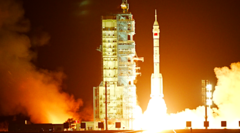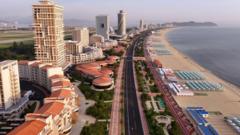China's space ambitions are soaring with the successful launch of the Shenzhou 19 spacecraft, which carried a three-member team to the Tiangong space station. This mission marks a significant milestone, not only for the inclusion of the first female space engineer, Wang Haoze, but also as part of China's broader goal to assert its dominance in space exploration. The crew is set to conduct critical experiments and prepare for future lunar missions, amid growing concerns over technological competition with the United States, particularly in lunar resource exploration.
China's Youngest Astronauts Embark on Historic Space Mission

China's Youngest Astronauts Embark on Historic Space Mission
China celebrates the launch of Shenzhou 19, featuring the nation's first female space engineer, as the crew prepares for a six-month stay at the Tiangong space station.
The successful launch of a three-person crew aboard the Shenzhou 19 spacecraft has been celebrated as a "complete success" by Beijing, marking another step in China's ambitious plans for space exploration. The spacecraft docked with the Tiangong space station following a journey of over six hours. The crew, which includes China’s youngest astronauts and its first female space engineer, Wang Haoze, will spend six months at the station carrying out experiments and conducting spacewalks. This mission is part of a record year with 100 planned launches as China accelerates efforts to establish itself as a key player in space.
The launch was witnessed by hundreds who gathered at Jiuquan Satellite Launch Center, waving flags and cheering as the astronauts were sent off. Pilot Cai Xuzhe, a veteran of previous missions, expressed pride and optimism, emphasizing the importance of inspiring youth and investing in the future of China's space program. Song Lingdong, one of the younger participants, recalled being moved by China's early missions and hopes to contribute significantly to his country’s legacy in space.
Despite achievements such as the retrieval of lunar samples and Mars landings, concerns from the U.S. over China’s rapid advancements and potential military objectives linger. NASA administration has identified a competitive atmosphere surrounding lunar expeditions, fueling fears of territorial stakes in space resources. Resiliency remains a focal point for the Chinese space program as officials work toward the long-term goal of lunar landings by 2030, highlighting the balance of scientific exploration and national pride.
China's space program not only serves national interests but also explores opportunities in international collaboration as officials propose peaceful advancements in space exploration. While plans for lunar resource extraction loom large, the challenges of acquiring and implementing advanced technologies are acknowledged. Ongoing research conducted on the Tiangong space station has revealed significant health insights related to microgravity, suggesting potential benefits for medical advancements on Earth.
The Shenzhou 19 mission, backed by domestic pride and significant government commitment, aligns closely with President Xi Jinping's vision of China as an emerging space power. Despite external critiques and internal challenges, the country projects a determined stance towards a future where space resources play a crucial role, reinforcing the narrative that competition in space is not only inevitable but necessary for progress in scientific discovery and technological innovation.
The launch was witnessed by hundreds who gathered at Jiuquan Satellite Launch Center, waving flags and cheering as the astronauts were sent off. Pilot Cai Xuzhe, a veteran of previous missions, expressed pride and optimism, emphasizing the importance of inspiring youth and investing in the future of China's space program. Song Lingdong, one of the younger participants, recalled being moved by China's early missions and hopes to contribute significantly to his country’s legacy in space.
Despite achievements such as the retrieval of lunar samples and Mars landings, concerns from the U.S. over China’s rapid advancements and potential military objectives linger. NASA administration has identified a competitive atmosphere surrounding lunar expeditions, fueling fears of territorial stakes in space resources. Resiliency remains a focal point for the Chinese space program as officials work toward the long-term goal of lunar landings by 2030, highlighting the balance of scientific exploration and national pride.
China's space program not only serves national interests but also explores opportunities in international collaboration as officials propose peaceful advancements in space exploration. While plans for lunar resource extraction loom large, the challenges of acquiring and implementing advanced technologies are acknowledged. Ongoing research conducted on the Tiangong space station has revealed significant health insights related to microgravity, suggesting potential benefits for medical advancements on Earth.
The Shenzhou 19 mission, backed by domestic pride and significant government commitment, aligns closely with President Xi Jinping's vision of China as an emerging space power. Despite external critiques and internal challenges, the country projects a determined stance towards a future where space resources play a crucial role, reinforcing the narrative that competition in space is not only inevitable but necessary for progress in scientific discovery and technological innovation.




















